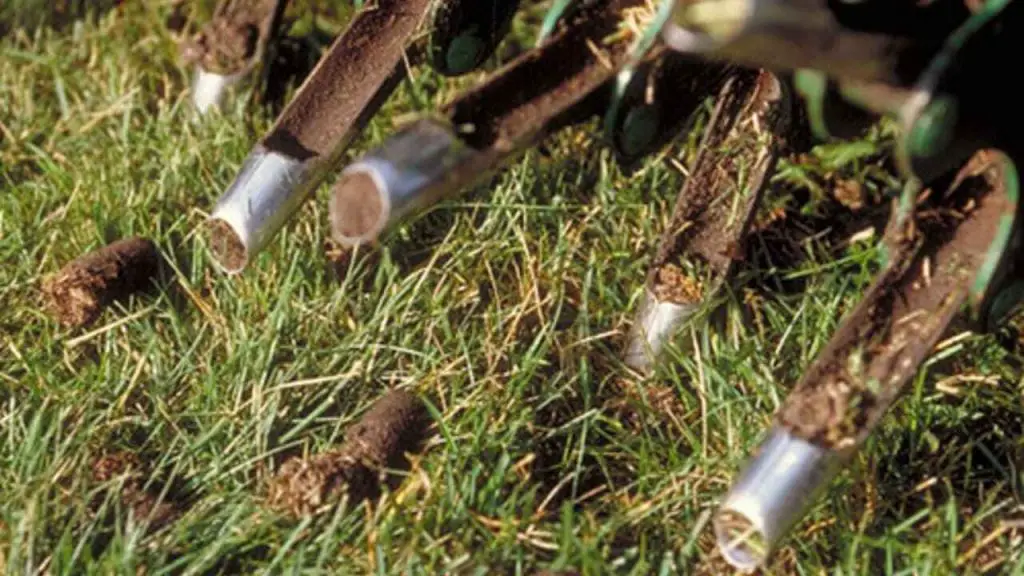Do you have a patch of garden that just isn’t growing as well as the rest of your lawn? It’s probably because the soil is compacted and doesn’t have enough air. Aerating soil can help to fix this problem, and it’s a pretty easy process!
In this blog post, we’ll show you how to aerate soil. Keep reading to learn more!
What Is Soil Aeration?

Soil aeration is the process of creating small holes in the soil to allow air, water, and nutrients to reach the roots of plants. This is usually done by using a garden fork or an auger. Soil aeration is important because it helps to improve drainage and prevents compaction. It also allows oxygen to reach the roots, which is essential for plant growth.
In addition, soil aeration helps to break up thatch, which is a layer of dead organic matter that can accumulate on the surface of the soil. Thatch can impede water and nutrient absorption, and it can also provide a welcoming environment for pests and diseases.
For these reasons, soil aeration should be carried out on a regular basis, particularly on lawns that are subject to high traffic levels.
Why Is Soil Aeration Important For Plant Growth And Health?
All plants, including crops and turfgrass, need oxygen for growth. The amount of oxygen that flows through the soil and gets to the roots is determined by the porosity of the soil, which is the air space within the soil particles.
If there are too many particles in a given amount of soil, then the porosity will be decreased and there will be less room for oxygen to flow. In order for plants to receive the oxygen they need, the soil must be properly aerated.
Aeration is the process of creating or increasing air spaces in the soil, which can be done mechanically or through natural means. This allows for increased airflow and gas exchange between the atmosphere and plant roots, which is essential for plant growth and health.
There are many benefits to aerating your soil, including improved water retention, better drainage, and increased nutrient uptake.
In addition, aeration can help reduce compaction, improve heat and cold tolerance, and promote deeper rooting. It is important to note that aeration should be done on a regular basis in order to maintain these benefits.
How To Aerate Soil Using Different Methods: Manual Or Mechanical
Aerating your soil is important because it allows oxygen to reach the roots of your plants. Oxygen is essential for the health of your plants, and it helps them to grow strong and healthy. There are two main ways to aerate your soil: manual or mechanical.
Manual aeration involves using a tool such as a pitchfork to make holes in the ground. This is a great way to aerate small areas of soil, but it can be time-consuming and labor-intensive.
Mechanical aeration is a more efficient way to aerate large areas of soil. There are many different types of mechanical aerators, but they all work by creating holes in the ground with special blades or tines. This allows oxygen to reach the roots of your plants, and it also helps to improve drainage.
Many people prefer mechanical aeration because it is less labor-intensive than manual aeration. If you have a large area of soil that needs to be aerated, then mechanical aeration is the best option.
Whichever method you choose, aerating your soil will help ensure a healthy lawn for years to come.
Benefits Of Aerated Soil For Plants, Lawns, And Gardens
Soil that is not aerated can cause a number of problems for plants, lawns, and gardens. Compacted soil doesn’t allow water, air, and nutrients to penetrate the roots of plants. As a result, the roots can’t take in the moisture and nutrients they need to thrive. This can lead to yellowing or wilting plants, as well as stunted growth.
Aerating the soil can help solve these problems by allowing water, air, and nutrients to reach the roots more easily. This encourages strong root growth, resulting in healthier plants. In addition, aerated soil is less likely to become waterlogged or compacted, making it easier to maintain healthy lawns and gardens.
The process of aeration helps to improve drainage and reduce compaction. As a result, aerated soil is ideal for growing healthy plants, lawns, and gardens.
There are a number of benefits to aerating your soil, and if you are interested in improving the health of your plants, lawn, or garden, then you should consider adding this important step to your gardening routine.
When Is The Best Time To Aerate Your Soil?
Aerating your soil is important to keep your lawn looking its best. But when is the best time to aerate? The answer may surprise you.
For most lawns, the best time to aerate is in the fall. The cooler temperatures and longer days give your grass a chance to recover from the process and prepare for winter.
Additionally, aerating in the fall helps to loosen compacted soil, allowing air and water to reach the roots of your grass. As a result, your grass will be better able to withstand the cold winter months.
However, if you live in an area with warm winters, you may need to aerate your lawn twice a year, once in the fall and again in the spring. By following these simple tips, you can ensure that your lawn stays healthy and beautiful all year long.
Are There Any Risks Associated With Soil Aeration That Gardeners Should Be Aware Of?
While soil aeration can be extremely beneficial for lawns, there are a few risks that gardeners should be aware of. First, if the lawn is dry, aeration can cause drying out and settling of the soil. Second, if done improperly, aeration can damage grassroots and cause compaction.
Finally, aeration can create an opportunity for weeds to take root in the newly-opened soil. However, these risks can be easily avoided by watering the lawn thoroughly before aeration and being careful not to compact the soil during the process.
With a little care and attention, soil aeration can be a great way to improve the health of your lawn.
Additional Contents



